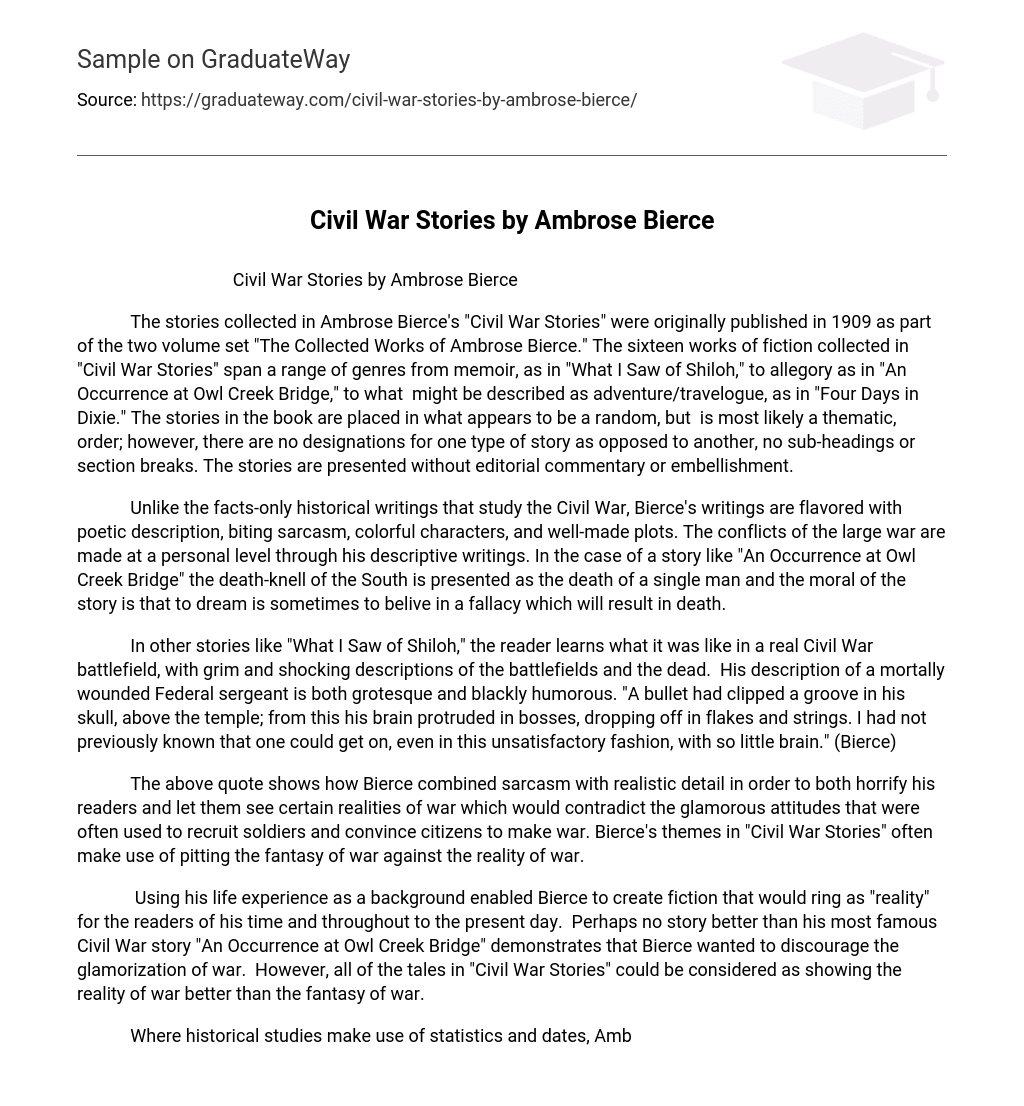The stories collected in Ambrose Bierce’s “Civil War Stories” were originally published in 1909 as part of the two volume set “The Collected Works of Ambrose Bierce.” The sixteen works of fiction collected in “Civil War Stories” span a range of genres from memoir, as in “What I Saw of Shiloh,” to allegory as in “An Occurrence at Owl Creek Bridge,” to what might be described as adventure/travelogue, as in “Four Days in Dixie.” The stories in the book are placed in what appears to be a random, but is most likely a thematic, order; however, there are no designations for one type of story as opposed to another, no sub-headings or section breaks. The stories are presented without editorial commentary or embellishment.
Unlike the facts-only historical writings that study the Civil War, Bierce’s writings are flavored with poetic description, biting sarcasm, colorful characters, and well-made plots. The conflicts of the large war are made at a personal level through his descriptive writings. In the case of a story like “An Occurrence at Owl Creek Bridge” the death-knell of the South is presented as the death of a single man and the moral of the story is that to dream is sometimes to belive in a fallacy which will result in death.
In other stories like “What I Saw of Shiloh,” the reader learns what it was like in a real Civil War battlefield, with grim and shocking descriptions of the battlefields and the dead. His description of a mortally wounded Federal sergeant is both grotesque and blackly humorous. “A bullet had clipped a groove in his skull, above the temple; from this his brain protruded in bosses, dropping off in flakes and strings. I had not previously known that one could get on, even in this unsatisfactory fashion, with so little brain.” (Bierce)
The above quote shows how Bierce combined sarcasm with realistic detail in order to both horrify his readers and let them see certain realities of war which would contradict the glamorous attitudes that were often used to recruit soldiers and convince citizens to make war. Bierce’s themes in “Civil War Stories” often make use of pitting the fantasy of war against the reality of war.
Using his life experience as a background enabled Bierce to create fiction that would ring as “reality” for the readers of his time and throughout to the present day. Perhaps no story better than his most famous Civil War story “An Occurrence at Owl Creek Bridge” demonstrates that Bierce wanted to discourage the glamorization of war. However, all of the tales in “Civil War Stories” could be considered as showing the reality of war better than the fantasy of war.
Where historical studies make use of statistics and dates, Ambrose Bierce’s fiction makes ample use of anecdotal evidence, and is often sheer fiction without even the pretext of being factually “true.” Instead, Bierce tries to express the essence of war through the immediate impact for better or worse on the individual person who experiences war. Also within the context of the lived-experience, Bierce is able to show the loss of innocence in a young person, as he does so well in “Four Days in Dixie” bit also the romanticization of youth and innocence even in the midst of the horrors of war, as he does in “What I Saw of Shiloh.”
In section 12 of that story, Bierce writes in a poetic, almost prose-poetry style and lets his glamorization of war shine through the memories of old-age. This is a bittersweet memory that you would never find related in a history book. It is fiction, of course because it is the poetic recollection of an event, but is also probably more faithful to life than any factually accurate treatise on dates and numbers in history.
The fact that Bierce could write “Give me but one touch of thine artist hand upon the dull canvas of the Present; gild for but one moment the drear and somber scenes of to-day, and I will willingly surrender an other life than the one that I should have thrown away at Shiloh” at the end of “What I Saw of Shiloh” — the same story that described the leaking brains of one of his wounded comrades, demonstrates how wide a range of emotions and beliefs that Bierce can cover in a single story that a history book would not cover.
The humorous aspect of Bierce’s writings also gives the memoir and fictional visions of the Civil War an authentic, real-life feeling, reminding modern readers that the people who fought and died in the Civil War or had their lives completely upturned by the war were people and not just anonymous casualties. By personalizing the war, Bierce may be offering his readers the chance to decide for themselves just how romantic war is and whether or not participating in a war is morally or even logistically advisable.
In “A Horseman in the Sky” Bierce offers one of the most climactic and sensational plot-twists in the book, which indicates just how hard it is to establish fiction from memoir in these stories. Of course the situation described in the story — that a son would shoot his own father — probably happened during the Civil War but Bierce’s version of it is certainly fictional and dramatized in order to leave the reader with a specific impact and meaning. The most illustrative aspect of “Civil War Stories” is not pictures, per se, but the dramatic mental images generated by Bierce’s writings.
Most readers will walk away from “Civil War Stories” with a deeper and more immediate grasp of the Civil War as it impacted those who participated in it and were touched by it on a personal level. This provides an excellent counterpart to the “big picture” view that is gained by reading strictly non-fiction studies of the Civil War.





